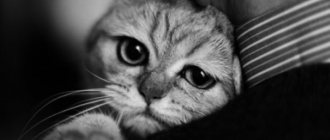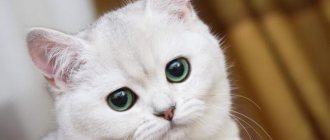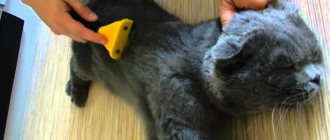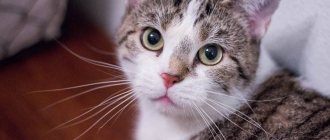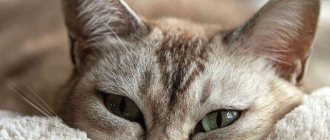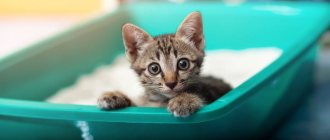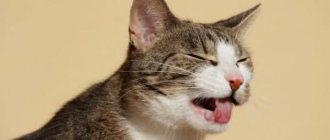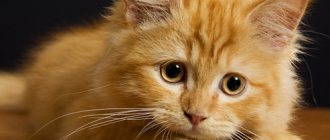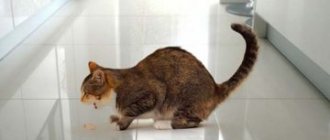Nature has blessed the Scottish Fold with thick, luxurious hair, despite the fact that the Scottish cat sheds heavily. Hair loss is often profuse and threatens to deteriorate its quality, forming areas of baldness. The causes of this condition may be stress, lack of calcium, medications or shampoos that cause allergies in the pet. To eliminate the root cause of hair loss in a cat, you need to observe the animal and then consult a veterinarian.
The main root cause of severe and constant shedding is improper, unbalanced nutrition, when the pet’s body lacks vitamins, macro- and microelements or fatty acids. To eliminate this pathology, it is necessary to correct the diet.
Preventing hair loss in cats
Seasonal molt
Beginning cat owners often panic when their cat begins her first seasonal shedding.
This usually occurs in spring and autumn. The behavior does not change, the cat is playful, the eyes are healthy and shiny, the nose is moist. Cats have a very delicate digestive system. Many owners love to feed their pet from their table, and then are surprised by the cat’s health problems. Human food flavored with spices, flavorings and salt is contraindicated for cats, as it causes severe hair loss - dermatitis. Excessive hair loss occurs. The cat's appetite worsens, it becomes lethargic and inactive.
If this problem occurs, you should put the cat on a diet: low-fat fish, kidneys, liver, cottage cheese. Give milk twice a week as independent nutrition. Vitamins containing biotin, B vitamins, antiallergic (tavegil or suprastin) and anthelmintic drugs are needed.
Hormonal disorders are also caused by special drops or tablets against the sexual desire of cats. Such drugs have a negative effect on the body and lead to diseases of the pet’s internal organs.
Dermatitis also occurs due to a cat’s reaction to a variety of synthetic substances, for example, to the product the owner uses to clean furniture, aerosols - air fresheners, or even to indoor plants.
If the fur begins to fall out in clumps, and round pink bald spots appear on the skin of cats, then you should think about the manifestation of the disease lichen. This disease is caused by a species of microscopic fungus. Ringworm is a highly contagious disease that also affects humans.
A cat can also become infected with skin mites. Hair loss is severe on the face, behind the ears and on the paws, and ulcers appear on the skin. The pet may even go bald.
You should definitely consult a doctor. After all, treatment takes place with toxic drugs and only a specialist can choose them correctly. Skin mites are not dangerous to humans. But the apartment should still be disinfected, and it is advisable to burn the cat’s bedding.
If your cat has been ill with any disease, then the immune system decreases and the hair begins to fall out. It is necessary to purchase special B vitamins for your pet and choose the right diet for the active development of the cat.
Nervous stress
Cats are very smart animals. They perceive current events very sensitively and can easily go into a stressful state. The reason may be moving to another place, for example, to the country in the summer. Death of the owner or any animal. The appearance of a new pet.
The cat's reaction to stress is manifested by hair loss, the cat spends more time washing itself. You should visit a doctor to really make sure that your cat is stressed and not sick.
The best way to relieve stress is simple affection, which needs to be given much more time. Medicines with a calming effect prescribed by a doctor will help.
Old age
As a cat ages, it begins to lack vitamins and essential minerals. All this is reflected in the fur; it begins to fall out in large areas.
It is worth mixing vitamins and nutritional supplements into food. There are various medicated foods on sale that will quickly help rid your cat of hair loss.
Caring for a cat's fur involves daily brushing. It is advisable to teach this from childhood, then it becomes a pleasant procedure for your pet. Brushing cleans the coat of dirt and hairs that have already fallen out. This is a kind of skin massage that improves blood circulation.
Proper nutrition
Organize your pet the right diet, add age-appropriate vitamins and mineral supplements to a varied diet. Do not overfeed older cats.
Be sure to vaccinate your cat against various skin diseases. A veterinarian will select preventative vaccines for you; they are individual for each cat.
Take care of your pet, feed it properly and brush it regularly, and your beloved cat will delight you with its health and beautiful fur coat!
The process by which the integument of animals changes is called molting. This occurs under the influence of a special hormone, most often in spring and autumn. The owners of such pets must be very observant so as not to miss the moment when your home is completely covered with fur.
Why do you need to watch your diet?
Fold ears need good nutrition, including a sufficient amount of vitamins and macro- and microelements. To maintain health, veterinarians do not recommend mixing dry and natural food. With a mixed diet, the animal’s fur becomes dull and then begins to “fall off.” If your Scottish Fold cat is constantly shedding, you should completely review the diet and change its composition. If necessary, consult a veterinarian. Due to the characteristics of the Scottish breed, such felines are characterized by a lack of calcium. And if changes to the cat’s diet are made correctly, then within a maximum of two weeks the fur will become thick and shiny.
Video review about cat shedding: an interview with a breeder and grooming expert about caring for a cat’s fur
- How to properly comb a cat?
- What to do if your cat sheds heavily all year round?
- Why do cats have more combs than people?
– Why do British cats shed? Cats typically shed twice a year.
If a cat sheds all year round, then the cat has health problems: 1. Worms .2. Disorders of the gastrointestinal tract.3. Problems with the pancreas.4. Liver problems.5. The cat is in constant stress (it is very afraid of something or someone, manipulations are often performed on it that it does not like).6. Problems with the anal sinuses .7. Lack of vitamins.
Your actions:
1. Give anthelmintic drugs2. Submit feces for clinical analysis.3. Donate blood for biochemical analysis.4. Remove sources of stress5. Empty the anal sinuses6. Introduce a complex of vitamins into your cat’s diet7. Show the cat to the doctor.
– Why do the British’s eyes water (run)?
Excessive tear production from the eye occurs in cats for several reasons:
1. Helminthic infestation. There are worms that pass one of the stages of their development in the lacrimal sac of the eye.2. Allergic reaction to a component of the external environment.3. Eye irritation, such as from tobacco smoke.
Your actions:
– Why is the British cat thin?
– Why are British cats angry?
Cats are most likely to become aggressive when they become distressed.
1. Stress develops with severe pain, with forced contact with a person. The owner often takes the cat in his arms and strokes it often. Children often forcefully touch the cat.2. New circumstances in a cat's life. The cat was moved to a new apartment, taken away from the dacha, and a new family member appeared in the family.3. Stress also develops in chronic diseases associated with pain.
Your actions:
Be sure to contact a zoopsychologist.
– Why does the British cat bite?
Cats bite in several cases:
1. Kittens up to 5 months old bite due to the hunting instinct, which is genetically inherent in cats. The need to bite in kittens subsides by the age of six months. This is especially true for their owners. The hunting instinct of adult healthy cats does not extend to people.2. Adult cats bite humans when they are under severe chronic stress.
Your actions:
1. Keep the kitten healthy and energetic
Everyone knows that representatives of the cat family periodically shed their hair, mostly seasonally. This process is called molting, and it is completely natural, so there is no reason to panic. This article will help you find out what to do when a British cat sheds heavily.
How to “convince” an animal
So, decide, if a British cat sheds a lot, what to do? What should you do correctly to avoid making mistakes?
Do not let the animal close to blazing heat radiators. Buy and install an air humidifier in your rooms. Open windows and doors often to ventilate the room. Don't be afraid to let in the cold, fresh air. By the way, this is also useful for people.
And on the loggia or balcony you need to arrange a “winter” house for the cat. Install a claw point fixture there. And all sorts of ladders, shelves, stands. Then the purr will be interested in going out onto the balcony.
About intense shedding in cats
Seasonal renewal of fur in cats is repeated in spring and autumn. At the same time, in representatives of long-haired breeds it falls out in whole clumps. Cats with missing undercoat shed less.
However, sometimes the process of fur coat renewal can be too pronounced in cats. No one can react indifferently to a situation when a Scot leaves whole clumps of his fur on the floor, chairs and other places. This is a concern for a responsible owner. He wonders why this is happening. Most often, this is caused by a deficiency of Omega-3 and Omega-6 fatty acids in the cat’s menu. Her body cannot produce these substances on its own. A deficiency of the above components is observed when the animal is treated with purely natural food. And when it consumes dry food of good quality, such a problem does not arise, since they contain the above-mentioned fatty acids in the required quantity. A lack of other minerals and vitamins also leads to intense hair loss in your pet. Sometimes they are simply not absorbed by the animal’s body. In this case, we are probably talking about hormonal imbalances, problems with the adrenal glands or thyroid gland, causing pathological molting.
Stress is another equally common cause of intense hair loss in cats. Representatives of exotic breeds of cats are very sensitive to a change in situation, owner, moving, physical punishment, and the appearance of a child in the family. Their body reacts to such situations with protest in the form of severe molting. Injuries are also a stress factor. Sometimes, despite seeming external well-being, an animal begins to shed intensively after falling from a height.
There are many diseases, a sign of which can also be severe hair loss. These are lichens, leukemic infection, allergic dermatitis. It can manifest itself in food components, medicines and hygiene products.
Pathological shedding in a Scottish cat goes away when its owner cures the cause that caused it. And you shouldn’t scold the cat, because he doesn’t shed his coat on purpose.
Cat shedding
In nature, life processes occur in cycles: birth, growth, rest and gradual extinction - this is a natural process. It’s the same with cats – the coat changes in a circular pattern. First, hair forms and begins to grow in the hair follicle - this is the growth stage. After the hair has grown, it remains in the follicle for a certain time - this is a period of rest. And then the hair stopped holding on, and the pet lost it.
During the molting period, the average ratio of growing and dying fur hairs in the coat is 1:1, i.e. half and half is the norm. By the way, during the winter season the animal almost stops shedding, because 90% of the hair is in the dormant stage.
The cat's hair is constantly falling out in clumps, all year round, in summer and winter: reasons
The causes of excessive hair loss, which is permanent, can be very different. However, they all indicate one thing: not everything is in order with the animal’s body. Let's look at it in order:
Lack of vitamins. The cat's diet should be balanced. Special food contains a certain amount of vitamins that are necessary for the cat’s body.
If you feed your cat natural products, pay attention to the diversity of the diet. Sometimes, due to an unbalanced diet, cats develop allergies or dermatoses. Hormonal disbalance
Often, owners suppress the cat’s sexual desire with special drugs. In this case, hormonal imbalance may occur. Along with hair loss, hormonal imbalance reveals itself through the following signs: cat apathy, reluctance to approach the food bowl, weakness, unusual behavior. Lichen. Round bald spots appear on the animal's body; the skin in these places may be reddened or too white, and there may also be scales. In this case, a visit to the veterinarian is extremely necessary, since the disease is dangerous, not only the animal suffers, but people can also become infected. Skin mites and helminths. A sign of skin mites is baldness of the face, paws, and ears. Pay attention to how often your cat itches. Helminths are also a serious problem; they have a detrimental effect on the functioning of internal organs and externally manifest themselves in the form of dermatoses.
It is a mistake to think that worms or skin mites cannot appear in a cat that does not go outside. Even if a cat does not eat raw meat, it is not a fact that it will not become infected with worms. These parasites can be brought into the house on shoes or clothes.
Dermatomycosis in cats
Important: Another cause of hair loss in cats can be stress. Like people, cats are prone to anxiety and overstimulation of the nervous system.
What may seem insignificant to a person may be perceived as painful by a cat. This includes physical and emotional factors.
Physical stress factors:
- Electric shock;
- Burns;
- Injuries;
- Past illnesses.
Emotional factors:
- Moving to a new place;
- The appearance of new residents (animals or people) in the house;
- Loss of owner;
- Restriction of freedom.
These or other events may not necessarily cause hair loss and deterioration of the cat’s condition, but it is still worth paying attention to the nervous shock of your beloved pet
Hair can be shed all year round
What to do?
The young girl now knows the answer to this question. But a year earlier...
After returning home, the cat team lost a lot of undercoat and guard hairs, even excessively. What's happened? Why? What to do?
Yana listened to my advice and immediately went to the veterinary clinic.
The doctor examined the animals and reassured the owner:
- the skin is clean, there are no blood-sucking insects;
- there are no bald spots or separate areas of baldness on the body of fluffies;
- a stool test did not reveal infection with worms, and a blood test for bacteria and fungi gave a negative result;
- Males and females are sterilized, which means they do not suffer from hormonal imbalances.
Wool is an indicator of a cat's health
The cat sheds a lot, what is the reason for this process, because shedding is a clear sign that not everything is going well for the cat?
When worms appear in cats, hair begins to fall out
A number of diseases lead to baldness in cats:
- Allergy. The most pressing disease of our time has not spared animals, who suffer just as much as humans. Allergic processes in cats can be triggered by inappropriate food or frequent treats, as well as cleaning products used in the house. Cat allergies are accompanied by itching, the animals become irritable and nervous, often itch, and traces of dandruff appear on the fur. Another sign of an allergy is watery eyes. To determine the cause of the allergy, it is worth changing the food and limiting the animal’s diet, eliminating various excesses. It also wouldn’t hurt to give an activated carbon tablet once a day.
- Worms. If the cat sheds a lot, the fur has become dull, there is an unpleasant odor from the mouth, and problems with the intestines are observed, the animal probably has a helminthic infestation. It is necessary to give the cat an anthelmintic recommended by a veterinarian, and repeat the procedure after 2 weeks. In the future, antihelminthic prophylaxis should be carried out at least once every 3 months.
- Fungal infections. Among them, the most dangerous disease for humans, transmitted from animal to owner, is ringworm. It is difficult for a non-specialist to recognize the types of fungal infections; for this purpose, a laboratory test is carried out and specific treatment is determined. Among the common signs:
- dandruff;
- dull coat;
- clear boundaries of bald patches;
- the hair breaks off in the middle;
- There may be sores and blisters on the skin.
Existing fleas and ticks cause severe itching, causing fur to fall out
The development of fungal infections is sometimes caused by excessive care of the owner, who scratches the cat too much - small scratches on the skin contribute to the development of a pathogenic environment. Frequently washing your cat also helps the fungus to appear. Only a specialist can completely cure a fungal infection by prescribing treatment, which may consist of antifungal ointments, sprays and medications or injections. It is better to start treating fungal diseases in time, especially if there is a small child in the house who does not often wash their hands after handling an animal.
- Skin parasites. Existing fleas and ticks cause severe itching - the cat actively itches and introduces infection into the wounds, and the hair begins to fall out. To eliminate skin parasites, there are single-use preparations that need to be dripped onto the animal’s withers.
- Hormonal problems. In adolescence, during pregnancy or after sterilization, the cat began to shed very much - this is how problems in the functioning of the internal organs (gonads, adrenal glands, thyroid gland) manifest themselves. To improve the condition of the animal, fatty acids should be added to the diet. It usually takes six months to restore hormonal levels after sterilization or pregnancy. While the cat is expecting kittens or feeding them, her diet must be supplemented with vitamin supplements.
How to deal with cat hair in an apartment
What to do if a cat sheds and how to remove hair from the floor, furniture and clothes? We will share with you universal methods of dealing with fluff in the house.
How to remove wool from the floor
The main assistant of any cat owner is a vacuum cleaner. Ideally, of course, a robot vacuum cleaner that will do all the work on its own while you enjoy a cup of aromatic tea. A regular vacuum cleaner does just as well, but requires your participation.
Wet cleaning should ideally be done daily, but rubbing with a cloth or waving a mop is very labor-intensive, and a home cleaner equipped with a surface-washing function will help you with this. However, a wet cloth perfectly collects hairs that a vacuum cleaner couldn’t handle. There are also special mops on sale with a rubber coating in the form of a roller that attracts hairs.
How to get rid of wool on a carpet
A turbo brush is the best way to remove wool from carpets. It wraps hairs and makes cleaning much easier. You can also use a stiff brush, but few people like crawling on the carpet on all fours.
How to clean furniture
Use a vacuum cleaner to clean furniture. Brush from top to bottom, first vacuum the shelves, then the fronts of the cabinets, then work on the window sills and only then move on to the beds and sofas.
There is an old but proven method for removing cat hair from upholstery: wet a sheet, cover the chair or sofa and tap it firmly with a beater.
How to remove cat hair from clothes and textiles
How to get rid of wool on clothes? It sticks to all fabrics and glitters treacherously on the street, revealing you as the owner of the cat. Hairs are especially noticeable on dark things.
The easiest way to remove hairs is with a wet palm. Run your hand over the clothing from top to bottom, rolling the wool into balls.
Use sticky rollers to clean things, choose reusable solid gel rollers to save your family budget. They can be washed with water.
To reduce static, wash clothes with conditioner or treat them with an antistatic agent. Keep closets closed and clothes hidden in covers.
Why and how cats shed
Subsequently, molting will become regular. For cats, this is a natural process of preparing for the change of season. Ideally, a cat sheds twice a year:
- before the cold weather begins. Reducing daylight hours and a significant decrease in temperatures include protective mechanisms that involve a change in wardrobe. Cats are rapidly growing a new coat that can protect them from frost. For example, the British grow a powerful, dense undercoat, which is much thicker than the summer one;
- before the onset of heat. Rising temperatures make it necessary to prepare for the summer heat. “Winter” fur, having served its purpose, is no longer needed. Therefore, a lightweight version is growing.
Cats that have free range react most strongly to the change of seasons. Their bodies are exposed to natural weather conditions and are sensitive to the changing seasons.
Cats living in an apartment without walking, despite the lack of seasonality in the home climate, also shed. Only the time of this process is not strictly tied to the environment. Depending on the breed, cats shed 1-2 times a year.
It should be borne in mind that in mature, uncastrated cats, shedding can begin at any time as a reaction to certain changes in physiology. This is how the body will react to hormonal changes during estrus or after kittens are weaned from mother's milk. This is not a reason to panic, you just need to provide your cat with improved nutrition and vitamins.
Baby shedding, or When Scottish kittens change their fur
Does your Scottish cat have a lot of fur the first time? Perhaps this is the so-called baby molt. When do Scottish kittens' coats change from baby to adult? The first molt occurs when cats are 5-6 months old, give or take. At this age, within 1-2 months, the Scottish cat's hair grows so much that it seems as if there will be no end to this problem.
The molting period of a Scottish kitten will end, but it can smoothly transition into a calmer phase, the duration of which sometimes reaches 1 year. During this period, the teenager must gradually change the primary, soft fur given to him from birth with adult, coarser, denser and more contrastingly colored fur. At the end of the child's molt, the coat becomes more beautiful, and the pattern required by the color appears in all its glory.
How long does seasonal molting last?
If you are scared by your kitten's long first molt, don't worry. This is due to complex processes of physiological maturation. Shedding in cats that can be called adults goes back to normal. On average it lasts a couple of months a year. Once in the spring, and again at the end of autumn. There may be minor time shifts in the schedule.
Usually short-haired pets fit into the schedule and timing of shedding. It’s more difficult with the fluffier ones. Persians or Maine Coons, after shedding their guard hairs, take a long time to get rid of the undercoat. They definitely won't be able to do it without your help. If you don't help them with their struggle, the consequences can be serious. From local tangles to completely matted fur.
Sometimes shedding in cats occurs unplanned or does not stop for a long time.
All cats are so different
The coat of Highland cats (that is, Scottish, long-haired cats) needs more careful care. But don't worry - it's not difficult at all. Highlands do not have such a voluminous undercoat as Persians, for example. That’s why there are no tangles. And you don’t need to comb the cat’s fur often, but from time to time.
This is how difficult it turns out to be to keep an animal at home. But if you do it with love, then you get a lot of joy in return.
Why does a Scottish cat shed a lot?
There are times when shedding is stronger than it should be, which threatens a deterioration in the quality of the coat and health and the torment of the owners, who will literally drown in the hair. The fact that shedding is excessive is indicated by the rapid deterioration of the coat and the formation of areas of baldness.
Before you begin to act, you need to find out the reason for the abnormally heavy shedding. To do this, you need to consult with a veterinarian, who may find some kind of disease in your pet.
The most common cause of severe shedding is poor nutrition, which lacks vitamins, microelements and fatty acids. To eliminate this problem, just read the information on how to properly balance the diet of a Scottish cat, and include vitamin complexes with Omega-3 and Omega-6 fatty acids in the diet.
However, it also happens that a cat receives all the vitamins, acids and microelements, but they are simply not absorbed. Most often this occurs due to hormonal imbalance, which, in turn, can be caused by cysts and tumors, poor functioning of the thyroid gland or adrenal glands. In this case, a veterinarian should take care of the treatment.
Methods for reducing hair loss
If there are no pathological causes of shedding that require immediate contact with a veterinarian, we will try to reduce it and correct the consequences.
The right diet
First of all, we will ensure that the cat’s body receives all the necessary substances. A pet's diet should include all the necessary macro- and microelements, vitamins and fatty acids. When eating only natural food, there may be a lack of Omega-3 and Omega-6, because... the body of a Scots cat does not produce these substances. A lack of vitamins is also possible.
Another feature of the Scots is their inability to produce enough calcium on their own. Therefore, in the case of eating natural food, it is necessary to introduce supplements of these substances.
Suitable dry food already includes everything you need. However, it is better to compare the content of its elements with the established standards mandatory for this breed, and, if necessary, introduce additives. The daily value is indicated on the package and depends on the age and weight of the animal.
Features of the British cat
The British cat was bred artificially by man. Using the selection method, almost “plush” animals were obtained that bring indescribable bliss to the owner. However, such cats have lost part of their resistance to diseases and the endurance inherent in their wild relatives. Therefore, they need to be given more attention and care.
Causes of shedding
There are several reasons:
- Seasonal molting occurs - in autumn and spring within one month. It `s naturally;
- Weakened immunity;
- Experienced stress;
- Pregnancy or postpartum period;
- Poor nutrition;
- Lack of vitamins and microelements;
- Allergic reaction to changing the type of food. For example, switching to dry food;
- Infection with one of the types of skin fungi;
- Hormonal imbalance due to a missed mating period or the use of hormonal drugs in the treatment of any disease;
- A serious disease that can only be diagnosed by a veterinarian.
What to do?
First of all, take care of the fur. Wash the cat with shampoos intended for this purpose, comb it and keep it in a room with a comfortable temperature. The coat should be smooth and shiny.
When changing these parameters, if the fur becomes dull and ruffled, immediately pay attention to nutrition. Is it complete and varied, are all the vitamins and microelements needed by your pet at different stages of life present?
After all, during pregnancy and especially after childbirth, you need a more carefully selected diet.
Special preparations and complexes are used, which are now abundant in veterinary pharmacies, making the coat delightfully soft and silky.
All possible stress factors are eliminated. Fluctuating temperature changes, unexpected loud sounds, encounters with other animals.
Even the appearance of strangers in the house can cause anxiety. British cats become very attached to their owners and experience serious shock in the presence of a stranger.
If the above conditions for caring for a British shorthair cat are met, the owner may not even notice how the seasonal shedding has passed.
If all the necessary precautions are taken, the threatening factors have been eliminated, but the animal continues to experience hair loss, then you just need to run to the veterinarian in order to prevent more serious consequences for your pet’s body. It’s worth starting with the fact that the molting process is a natural physiological manifestation in the life of a pet.
Almost everyone is susceptible to seasonality. Pets can shed at any time of the year, other cats only change their hair coat
It’s worth starting with the fact that the molting process is a natural physiological manifestation in the life of a pet. Almost everyone is susceptible to seasonality. Pets can shed at any time of the year; other cats only change their hair coat.
Symptoms of skin and endocrine system diseases
External signs will tell you about skin diseases. If redness, scratching, bald spots, or abscesses appear on the skin, this is a significant reason to consult a veterinarian. The causes of such diseases are numerous - from banal allergies to parasitic and oncological ones. Only a veterinarian can install them.
Diseases common to humans are also observed in cats. In the field of endocrinology, these are obesity, diabetes mellitus and diabetes insipidus, acromegaly, hypothyroidism, etc.
To diagnose these diseases in animals in a timely manner, you need to pay attention to their behavior. Even the smallest details that are not typical for a pet are a reason to go to the veterinary clinic.
If your cat drinks or eats a lot, goes to the toilet frequently, doesn't move much, or has lost his appetite, all this indicates the need to visit a doctor. The doctor, having done the necessary research, will be able to determine why your cat’s hair is shedding a lot.
It is impossible to determine the cause on your own, without additional tests and other diagnostic methods.
Are there any non-shedding cat breeds?
The desire to have a cat with a flowing coat can be realized without the exhausting struggle with shedding if it is possible to have a Burmese, American Curl, Somali or Turkish Angora.
Shorthaired Siamese, Abyssinians, Burmese, Bengals, Singaporeans, Egyptian Mau or Bombay cats will cause minimal problems.
There is a completely exotic solution to the shedding problem: rexes and sphinxes. These cats definitely do not shed in the traditional sense of the word.
Choose a cat with the prospect of spending at least 10 years side by side with her, and with a successful combination of circumstances, as many as 20. The shedding of Persians, Britons, Siberians or Maine Coons has made them not the most popular among lovers of order and cleanliness in the house. No amount of care or improved nutrition can prevent their marks from appearing in the most inappropriate places.
A healthy cat living outdoors sheds twice a year, in spring and autumn. By summer, cats actively shed their fur in preparation for the hot season. In autumn, on the contrary, they increase their fur coat in anticipation of the winter cold. Animals living in an apartment are also subject to shedding, but often this process is delayed or becomes uncontrollable when the cat sheds heavily almost all year round.
If your pet is an apartment dweller, without access to “free range”, then most likely he is prone to increased hair loss. In winter, when the fur coat should grow, the opposite process is observed. In apartments with central heating, dry and warm air dictates the animal to shed excess fur for a more comfortable feeling. A hot battery replaces thick winter fur for our pets, and artificial lighting and, as a result, longer daylight hours complete the picture.
To avoid hair loss from overheating, if possible, keep the animal away from radiators, install air humidifiers, and ventilate the apartment more often. If you have a balcony or loggia, set up a “winter” house for your cat on the balcony, install scratching posts, multi-level shelves and ladders there so that the animal is interested in going out into the fresh air.
Gastrointestinal disease or hormonal imbalance
Some breeds with a thick undercoat, in particular, British, Siberian, Maine Coons, shed all year round, so if there are no other visible problems with the coat, then there is no reason to worry.
Animals that spend the winter months in an apartment and move to the country in the summer tend, on the contrary, to increased hair growth in the summer months, when they have access to walking, and therefore upon returning to a city apartment are subject to more intense molting.
Considering seasonal factors and the specifics of keeping pets, it is very important not to mistake skin diseases for normal shedding. Such diseases include allergic reactions to food or medications, fungal diseases
Hair loss can be associated with gastrointestinal and hormonal problems and may be accompanied by itching, redness, and the formation of patchy bald patches.
Do not self-medicate under any circumstances; take the animal to the veterinarian.
The clinic will do the necessary tests (scraping at the site of alopecia, blood test), conduct diagnostics and prescribe treatment. It is possible that excessive hair loss is due to a lack of vitamins, in which case the doctor will recommend a complex that is suitable for your pet.
Most often, cats with focal lesions are prescribed simple and effective vitamins, for example, brewer's yeast. If all other vital signs of the animal are normal, then within two weeks you will notice a significant improvement in the condition of the hair coat.
Shedding may be associated with food changes
The cat sheds heavily due to problems with the gastrointestinal tract or food-related allergies. Excluding certain foods from the diet, as well as adding vegetable fats, will help restore your pet’s coat and return it to its usual shine and shine.
Change your diet completely
This is the situation: it is clearly visible that the cat is shedding a lot. What to do? You are looking for the reason, and it is quite simple - you offered the cat new food. So, exclude certain foods from the animal’s diet and don’t experiment anymore! And adding vegetable fats to food will only help to quickly restore the shine and beauty of your beloved cat’s “fur coat”.
It is recommended to brush the coat regularly. There are cats that are predisposed to hair matting. The same Persian or Siberian ones. It is best to brush them every day. And not just an ordinary comb, but a special one - a furminator. It significantly reduces shedding and prevents the formation of tangles.
Caring for British women
Caring for cats of the British breed cannot be called special, and keeping these plush creatures is not at all difficult. However, you still have to take some nuances into account, especially if you want your pet to shine at exhibition events and participate in breeding.
| Wool | The coat is the main advantage of the British, so it should be looked after very carefully. Get ready to brush your pet 1-2 times a week with a special massage brush called a slicker brush. With its help, you can remove all the dead hair that is creeping in, and also give a great massage, even when cats sleep on their backs. The structure of the coat and its condition largely depend on the pet’s diet. It must contain all nutrients, calcium, vitamins and microelements. It is enough to wash a short-haired blue cat 1-2 times a year. |
| Claws | Any domestic cat does not have the ability to sharpen its claws properly, even if it has a scratching post. Therefore, a Briton’s nails need to be trimmed 1-2 times a month. Cut them carefully, about half the entire length, no more. |
| Eyes | A Briton's eyes should be looked after at least once a day, since dark secretions should not accumulate in them. Wipe your pet's eyes with a damp cotton swab, starting from the outer corner and ending with the nose. |
| Ears | The ears should be examined 2 times a month. Contaminants are removed with a regular cotton swab dipped in boiled water. The exposed ear surface can be wiped with a small amount of Vaseline or cosmetic cream. |
| Teeth | Inspect your British woman's oral cavity daily. Due to the fact that at home the cat cannot chew twigs and grass to clean its teeth, over time it may develop tartar. To prevent this from happening, try to accustom your kitten to brushing its teeth using a special product from an early age. Ready-made dry food also helps dissolve plaque. It is worth noting that feeding in this case should occur regularly, and not just to remove dental plaque. |
If British kittens have everything they need for full development, and the owner takes care of them on time, no problems will arise in keeping these animals.
How to use cat hair
Does cat fur have any uses? Of course, you don’t have to throw it away, but put it to use. The hair has a gorgeous shine and a silky structure. From wool you can make a blanket, mattress cover, blanket, sciatica belt, and use fluff for wet and dry felting.
The dry felting method is used to create three-dimensional products. The fibers are tightly connected and form felt. Wet felting is ideal for creating small toys or decorations.
In Switzerland, cat hair has long been used to treat osteochondrosis. Their fluff is used to make belts and socks to increase blood circulation and relieve joint pain.
Some craftsmen make expensive jewelry and designer bags from wool.
Features of the British cat
The British cat was bred artificially by man. Using the selection method, almost “plush” animals were obtained that bring indescribable bliss to the owner. However, such cats have lost part of their resistance to diseases and the endurance inherent in their wild relatives. Therefore, they need to be given more attention and care.
Causes of shedding
There are several reasons:
- Seasonal molting occurs - in autumn and spring within one month. It `s naturally;
- Weakened immunity;
- Experienced stress;
- Pregnancy or postpartum period;
- Poor nutrition;
- Lack of vitamins and microelements;
- Allergic reaction to changing the type of food. For example, switching to dry food;
- Infection with one of the types of skin fungi;
- Hormonal imbalance due to a missed mating period or the use of hormonal drugs in the treatment of any disease;
- A serious disease that can only be diagnosed by a veterinarian.
What to do if the cause of molting is illness?
The Scottish Fold differs from other cat breeds by its unusual folded ears. This is a gene mutation. Due to genetic characteristics, the cat has thick, beautiful fur. It falls out and is renewed almost all year round. But, if the hair loss is intense, the cause of molting may be health problems. The most common of them:
- Diseases of the stomach and intestines. Food is retained in the intestines and disrupts digestion; nutrients do not enter the blood in the required quantities.
- Skin ailments.
- Parasites (fleas, worms). Because of them, cats scratch their skin and chew out their fur.
- Kidney diseases.
- Constant stress. They can be caused by moving, childbirth, or surgery.
- Hormonal disbalance. With this pathology, beneficial substances are simply not absorbed by the cat’s body.
If the cause of abnormal molting in a Scottish Fold is a disease, you should find out what triggered it. The veterinary clinic will prescribe and carry out all the necessary tests, determine the diagnosis and prescribe the appropriate treatment. To prevent the accumulation of hairballs in your pet’s gastrointestinal tract, you need to provide him with access to fresh grass. You can buy it or simply plant it on a balcony or windowsill. The plant will help the cat regurgitate accumulated hairballs. The specialist will recommend special cat treats or food that contain ingredients that provoke hair loss.
Other Causes of Hair Loss
If your pet suddenly begins to shed not in adolescence or on the eve of summer (winter), this means that he has other reasons for shedding his fur that need to be found out and corrected.
If a cat sheds its fur during pregnancy or lactation, this means that it lacks certain vitamins and minerals that need to be replenished with the help of vitamin complexes and food regulation.
A cat can also shed its fur as a result of parasitic or infectious skin lesions (for example, ringworm).
In addition, the animal may go bald due to stress caused by moving to a new home, the death of a family member, or the arrival of a new pet or child. There may be other reasons for worry.
The reason is the aforementioned lack of fatty acids, vitamins and minerals, which can provoke not only increased seasonal shedding, but also shedding of fur when it is not supposed to.
Perhaps your pet's hair loss is caused by allergies or leukemia.
In any case, the diagnosis must be made by a veterinarian, since your treatment can only cause harm.
Care depending on color
Depending on the color of the Scottish cat, coat care may vary. So, for example, black cats are given certain shampoos to enhance their color, while white cats are given different shampoos, and so on.
There are also some nuances in combing. It is highly not recommended for smoky cats to use slicker brushes with furminators, because... they damage the undercoat - as a result, the color deteriorates.
In addition, if you comb a solid-colored cat (white, black, blue, etc.) at the wrong time, causing it to develop tangles, they can be cut out. But cats of smoky and point colors cannot do this, because... leads to the formation of spots of a different color. For such cats, you can only carefully separate the hairs in the mat so that it disappears.
Source
Scottish Fold: Questions and Answers
Before asking your question, please make sure that this question has not already been asked
- A kitten up to 2-2.5 months should not leave its mother’s house!
Buy a kitten from a clean home, with deworming (that is, when the kitten was given an anthelmintic drug), with vaccinations and documents (veterinary passport and birth certificate or pedigree from the club).
Only in this case can you be relatively calm about the health of your pet. The normal age for buying a kitten is 2.5 months or more. - Before asking your question, look for a similar question and its answer in previous posts.
- All questions about the health of your pets should be directed to the vet.
section _
Remember that sometimes it is very difficult to give an answer about diagnosis and treatment in absentia
.
Experts may not answer your questions:
— about the health of the kitten, if you took it from its mother prematurely, unvaccinated and without documents; — about how to feed a kitten, how much it should weigh and other questions to which answers were given repeatedly.
Answers to questions on the topic:
Compliance with standards and colors
CATS catalogue. Scottish fold
Sale of British and Scottish fold kittens.
Professional nursery Phyllis offers British and Scottish fold kittens of a chic breed type. From titled parents. Colors from traditional to rare. All kittens are litter box trained and vaccinated according to age. Details on the website. We are happy to help you choose a pet. E-mail Website https://www.phillis.ru Tel. 8-499-732-63-83 (after 16 hours); 8-903-754-03-08 any time
Source
Vitamins and supplements for wool
Caring for the coat of a Scottish cat also involves periodically taking vitamins and minerals. Vitamins can be purchased at a pet store or veterinary pharmacy. Or, instead, purchase regular brewer's yeast from a human pharmacy. It is especially good to drink this course during molting. However, cats consuming fortified factory food cannot additionally take such complexes.
In addition, do not forget about special pastes and food for removing hair that gets into the stomach, which inevitably happens during licking. Also plant grass on the windowsill so that the cat can periodically regurgitate this fur: the grass is not digested, irritating the digestive tract, as a result of which lumps come out with it during vomiting. Cats, intuitively feeling that grass will help, eat it with pleasure.
Arch-comb
For sale on the Internet you can find such a device as an arch for combing wool. This is something like a curved brush that is placed on the floor on a special stand. An animal, eager to scratch itself, begins to rub against this arch, thereby putting itself in order.
But whether your cat wants to use such a device is purely individual. To attract the animal to the unit, it is recommended to use catnip.
However, in any case, the arch is only an additional, and not the main tool when combing cats. She cannot comb it properly.
Other Causes of Hair Loss
In pregnant fold-eared cats, the intensity of hair loss increases. This continues until childbirth. This is normal. Before giving birth, in order to make it easier for the kittens to access the nipples, the cat often chews out the fur on her tummy. The condition of the coat can be affected by age, or more precisely, by the onset of old age. Scottish Folds go bald when they reach 10-13 years of age. This occurs due to a slowdown in vital signs. They start to freeze. To prevent this from happening, you need to monitor the temperature, nutrition, well-being, and always love and protect your pet.
Source
